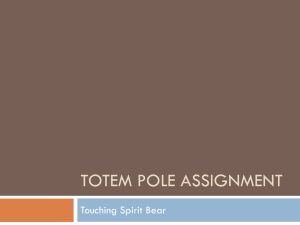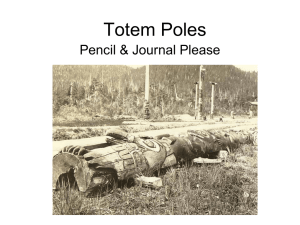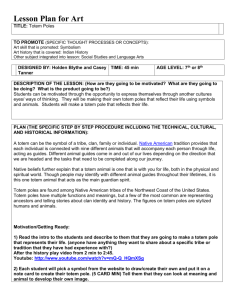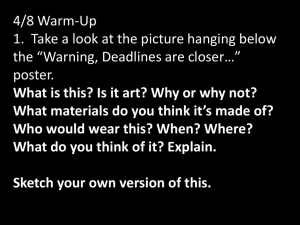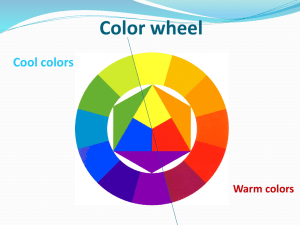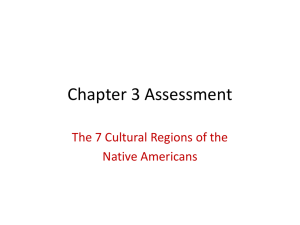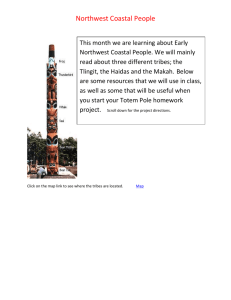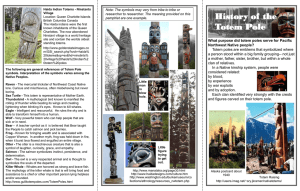Project Name: Native American Totem Pole Lesson Plan
advertisement
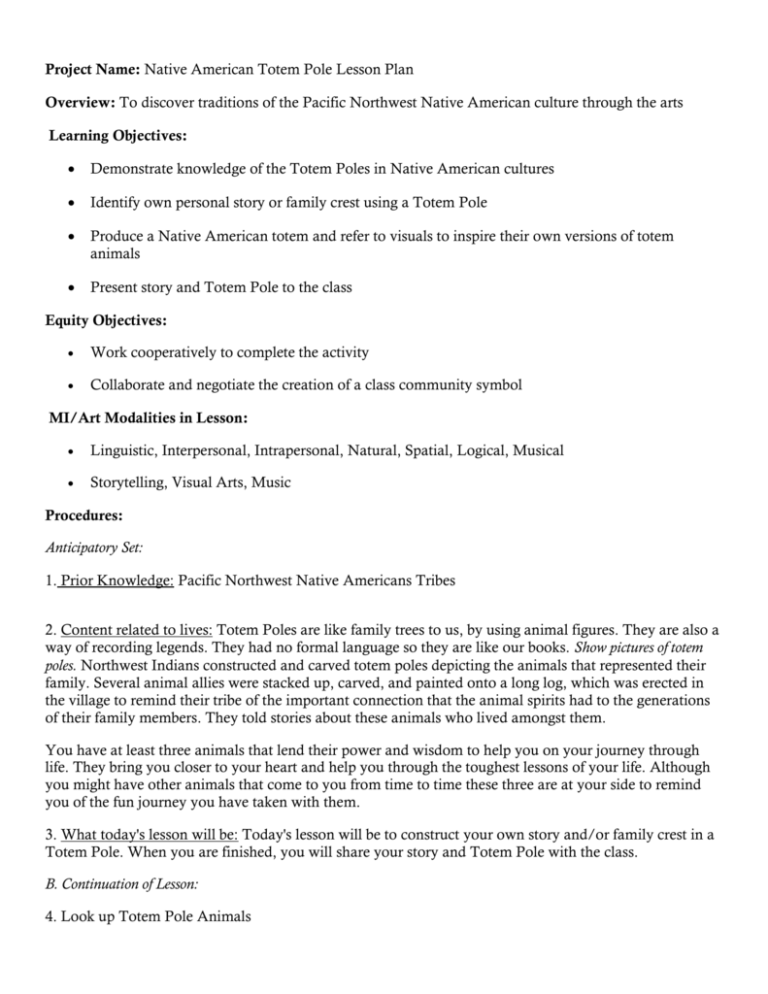
Project Name: Native American Totem Pole Lesson Plan Overview: To discover traditions of the Pacific Northwest Native American culture through the arts Learning Objectives: Demonstrate knowledge of the Totem Poles in Native American cultures Identify own personal story or family crest using a Totem Pole Produce a Native American totem and refer to visuals to inspire their own versions of totem animals Present story and Totem Pole to the class Equity Objectives: Work cooperatively to complete the activity Collaborate and negotiate the creation of a class community symbol MI/Art Modalities in Lesson: Linguistic, Interpersonal, Intrapersonal, Natural, Spatial, Logical, Musical Storytelling, Visual Arts, Music Procedures: Anticipatory Set: 1. Prior Knowledge: Pacific Northwest Native Americans Tribes 2. Content related to lives: Totem Poles are like family trees to us, by using animal figures. They are also a way of recording legends. They had no formal language so they are like our books. Show pictures of totem poles. Northwest Indians constructed and carved totem poles depicting the animals that represented their family. Several animal allies were stacked up, carved, and painted onto a long log, which was erected in the village to remind their tribe of the important connection that the animal spirits had to the generations of their family members. They told stories about these animals who lived amongst them. You have at least three animals that lend their power and wisdom to help you on your journey through life. They bring you closer to your heart and help you through the toughest lessons of your life. Although you might have other animals that come to you from time to time these three are at your side to remind you of the fun journey you have taken with them. 3. What today's lesson will be: Today's lesson will be to construct your own story and/or family crest in a Totem Pole. When you are finished, you will share your story and Totem Pole with the class. B. Continuation of Lesson: 4. Look up Totem Pole Animals 5. See copies of animal descriptions here and below: Bear = symbol of strength; Beaver = symbol of wealth and gives "medicine power"; Frogs = bring good fortune; Raven = guardian spirit; Salmon = symbol of wealth, fertility, immortality; Snake = brings power of magic; Thunderbird = chief of all guardian spirits, causes thunder and lightning; Whale = bad spirit who brings destruction; Wolf = helpful spirit who also brings skill in weaving and woodcraft. 6. Tell students they will make their own Totem Pole based on their family traits. Give students 5-10 minutes in a quiet place outside to think about animals and to choose 3 that represent their family or life and why. (writing this down might help with presentation) - The totem that appears at the bottom of your totem pole guides you from below and into your dreams. - The totem that appears in the middle of your totem pole is your heart and helps you be a better friend to others. - The totem that appears at the top of your totem pole guides you from the spirit world and protects you always. 7. Students then draw their 3 animals (minimum) that represent their personal totem pole and then cut the totem shapes from construction paper. They can use the copy of animal description as a reference, as well as their digital devices. Animals need to be a minimum size of one (1) 8x10 piece of construction paper. Students then glue animals to cardboard tubes to create a Totem Pole that tells their story. C. Closure: Let students share their Totem Poles and tell their stories. Display Totem Poles on a flat surface where they can be freestanding as an ongoing exhibit. Assessment Strategies: Authentic Tasks - making of a Totem Pole and story Writing project - writing a story Observation of cooperative group work, i.e., fair sharing of work, enjoying helping other classmates Anecdotal records Observe brainstorming techniques for storyline Ask questions, i.e. why pick a certain animal for a certain character in the story Portfolios - save some samples of work, i.e. Totem Poles and stories Adaptations: This lesson could be adapted to 8th grade U.S. History during the time period of early explorers in the West (Lewis and Clark) and the Louisiana Purchase. Some modifications and adaptations would be that instead of performing this task alone students would create a story and totem pole in a group of four to five students. They will be responsible for brainstorming and writing out the story together, as well as creating props needed during their performance, and their totem pole to go along with their story. They will be turning in their written story, and acting out the story as a group. The performances should be no more than 15 minutes long. Afterwards, the rest of the class will discuss their story and try to come up with the meanings and symbols represented in the story and match them to the symbols/meanings on the totem pole that the group had created. The group will be graded on group cooperation, presentation, effort, and their totem pole. Resources: Tantlinger, E. (1999, September 14). Totem Pole. Retrieved June 25, 2009, Web site: http://www.eduref.org/Virtual/Lessons/Interdisciplinary/INT0143.html Greene, A. (2005). Animal Tribe: Build your own totem pole. Retrieved June 17, 2009, Web site: http://www.animaltribe.com/TotemPole-LessonPlan.pdf 1. What Are Totem Poles Totem Poles are not difficult to identify, whether you're looking at a reproduction in a gift shop, or a lonely figure decaying quietly in the forest. As recognizable as they are, however, they defy typically western classifications. 2. Totem Poles Totem Poles were an important part of tribal life for the people of the Northwest. Tribal and family history were embodied and personified in the totems which all individuals carried with them as an integral part of their personal identity. All family and tribal homes proudly displayed their tribal totems - for all to see. 3. Constructing a Totem Pole Contrary to what most people believe and understand about totem poles, the Haida people constructed these poles, not for religious purposes, but to preserve their culture and heritage for future generations. To the untrained eye, totems are carvings of religious figures and coastal animals, but to the Haida people these poles held a deeper meaning. 4. Totem Poles: An Exploration Carved from mature cedar trees by the Native people of the Northwest Pacific coast (British Columbia, Canada and southern Alaska, USA), full size totem poles are outgrowths of the region's aboriginal art forms. Originally an important part of the Potlatch ceremony, a feast with deep meaning to coastal First Nations, totem poles were once carved and raised to represent a family-clan, its kinship system, its dignity, its accomplishments, it prestige, its adventures, its stories, its rights and prerogatives. A totem pole served, in essence, as the emblem of a family or clan and often as a reminder of its ancestry. 5. Western Red Cedar The western red cedar is found mainly in Western Canada and the United States. In the past, Amerindians sculpted totem poles and dugout canoes up to 20 metres long from western red cedar logs. One of these canoes is on display at the Canadian Museum of Civilization in Ottawa. 6. Towering Totems 7. Aesop's Fables On-line 8. Raven and Crows Crows, ravens, jays and magpies are all corvids, and are some of the most intelligent of birds. Farmers know that crows can count to four or five: the birds are wary of people and if three hunters enter a blind to shoot at them, the crows won' tcome near. Even if one or two hunters come out again, they aren't fooled. Not until five people go into the blind and four come out will the crows think it's safe to return. 9. Native American Lore Index Page Below are links to several storys of Native American Indian Lore from several Tribes across Turtle Island. If you have a story of Native Indian Lore you would like to have posted here, send it to me with as much information about the Lore that you can, and I will post it with others found here. Help me to make this site the best Lore site on the Web . 10. The Story of Totem Bight A Tlingit myth tells that the people were inspired to carve totem poles after finding a carved log washed up on the beach. The Haida tell of a master carver who created a house front and several poles overnight and then taught the villagers how to carve. 11. Totem Poles The totem poles of the Northwest Coast First Nations are probably the most immediately recognizable artifact of the culture. The poles are carved from red cedar with stylized human and animal forms. The figures on the pole represent theancestry of a particular individual or family, and usually each image has a story connected to it. 12. Emily Carr; To the Totem Forest Emily Carr visited Sitka, Alaska, in 1907; there, for the first time, she saw totem poles standing in a forested setting. Ironically, these were in a park, having been relocated from Haida and Tlingit Indian villages in a scheme to preserve them from vandalism. They so impressed her that she resolved to record all the standing totem poles in British Columbia. 13. To the Totem Forest Totem poles, donated by Tlingit and Haida chiefs to the Alaska Territorial government, were shipped in 1904 to St. Louis for display at the World's Fair. Upon their return to Sitka in 1906, the poles were reerected in a park that was eventually dedicated as the Sitka National Monument. 14. Totem Pole Ceremonies Raising a totem pole in the traditional way is a major project. First a hole must be dug to nest the pole in, then the pole is ceremonially carried to the site - depending on the size of the pole, a hundred or more people may be needed to help carry! When the uncarved end is placed in the hole, some people pull with strong ropes while others push from below with long poles, raising the pole in stages, to the accompaniment of drumming, singing and dancing. 15. Lesson Plans: Religion and Spirituality in Native Cultures Objectives: Students will gain an appreciation for the central role that religion and spirituality holds in Native cultures. 16. Emily Carr Emily Carr's first paintings of B.C. Indians, their villages, their totem poles, the forest and the seas, are those of a documenter. 17. Totem Poles; An Introduction While totem poles are thought by many to be a symbol of Native American culture generally, their production was limited to six tribes in British Columbia and southeastern Alaska. The tribes which carved totem poles were the Bella Coola, Haida, Kwakiutl, Tlingit, Tsimshian and West Coast. Pole carving flourished in the 19th century. 18. Intro to Totems and Totem Poles Carved from mature cedar trees by the Native people of the Northwest Pacific coast (British Columbia, Canada and southern Alaska, USA), full size totem poles are outgrowths of the region's aboriginal art forms. Originally an important part of the Potlatch ceremony, a feast with deep meaning to coastal First Nations, totem poles were once carved and raised to represent a family-clan, its kinship system, its dignity, its accomplishments, it prestige, its adventures, its stories, its rights and prerogatives. A totem pole served, in essence, as the emblem of a family or clan and often as a reminder of its ancestry. 19. Northwest Indians: The Totem Pole Search The Northwest Indian region is located along the Pacific Ocean from southern Alaska to northern California. Some of the Northwest tribes are the Chiook, Eyak, and Tlingit. A common form of artwork among the Northwest Indians is the totem pole. These totem poles were often used to show family ancestory and social rank. Totem poles became even more dominant among the tribes after the white traders brought iron tools 20. Alligator Maternal, revenge oriented, quickness, aggression, and basic survival instincts. Ant Group minded, determination, patient, active, and industrious Anteater Lethargy, curiosity, nosiness. Antelope Active, agile, jumpiness, and willing to sacrifice Armadillo Safety oriented, grounded, and has boundaries Badger Courage, aggressive, healer, having problems relating to others, and energy conduit Bat Rebirth, longevity, secrecy, initiation, good listener, and long life Bear Industrious, instinctive, healing, power, sovereignty, guardian of the world, watcher, courage, will power, self-preservation, introspection, and great strength. Beaver Determined, strong-willed, builder, overseer, and protector Bee Organized, industrial, productive, wise, community, celebration, fertility, defensiveness, obsessive nature, and enjoys life Boar/Pig A very powerful totem - prosperity, spiritual strength, organized, self-reliant, fearless. Buffalo Sacredness, life, great strength, abundance, gratitude. Bull Insight into the past, fertility, rushing into things without proper preparation. Butterfly Metamorphosis, transformation, balnace, grace, ability to accept change Camel Survival, positive, accomplishments Caribou Traveler, mobility, preference to be nomadic, adaptability to adversity Cat Guardianship, detachment, sensuality, mystery, magic, and independence Cheetah Swiftness, insight, focus Cougar Leadership, loyalty, courage, taking responsibility, foresight Cow Swift, insightful, and focused Coyote Trickster, intelligence, stealth, wisdom and folley, guile and innocence Cobra Swift and decisive Crab Good luck, protection and success Crane Solitude, justice, longevity, independent, intelligent, and vigilant Crocodile Ensuring your emotions are displayed accurately/appropriately Crow Justice, shape shifting, change, creativity, spiritual strength, energy, community sharing, and balance Deer Compassion, peace, intellectual, gentle, caring, kind, subtlety, gracefulness, femininity, gentleness, innocence, and seller of adventure Dog Noble, faithful, loyal, teaching, protection, and guidance 21. The First Totem Pole; A Story Written by Rosa Bell, Illustrated by Christian White Many, many years ago a Haida family lived in a village called Yan. In that family there was a boy named Sta-th. He was one of the Eagle clan. He wore an Eagle carving around his neck. Sta-th's mother was called Koon-jaat. She was also from the Eagle clan. Her hat had an eagle on top of it. Sta-th's father'sname was An-o-wat. An-o-wat was from a different clan. He was one of the raven clan. He wore a Raven crest on his clothes. 22. Saxman Native Totem Park In the late 1930's the Civilian Conservation Corps and the U.S. Forest Service retrieved and restored totem poles from abandoned village sites. This resulted with Saxman being one of several Native communities in Southeast Alaska with a totem park. The 24 totem poles in the Saxman Native Totem Park came from ancestral villages at Cape Fox and Tongass Island, Cat Island, and Pennock Island. This is the largest totem park in the world. Get on the Blog for the reference image. DO NOT cut this paper. It will not be big enough. **You need to draw it **
